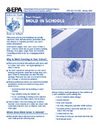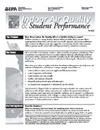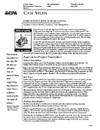The Media
|
|
|
Follow the links below to information prepared especially for you!
- School and District Officials
- Teachers and Students
- Facilities Staff
- Parents
- Health Care Professionals
- The Media
Envisioning Excellence: Lessons from Effective School Indoor Air Quality Programs. Learn more about this exciting tool.
Media Resources
What Kind of Media Resources Does EPA Have?
EPA has designed materials specifically for the media so that they can easily participate in the national effort to raise awareness of school IAQ issues. EPA provides:
- The latest statistics and educational materials
- Videos that describe the risks of poor IAQ in schools
- Information on IAQ-related health risks, including mold problems and asthma triggers
Fact Sheets, Videos and Brochures to Educate the Public about School IAQ Issues
 |
Mold in Schools Fact Sheet The Mold in School Fact Sheet provides an organized summary of information related to facts of mold growth in school buildings and portable classrooms. Concern about indoor exposure to mold has been increasing as the public becomes aware that exposure to mold can cause a variety of health effects and symptoms, including allergic reactions. Parents are especially concerned about the conditions of school buildings and how mold may affect their children. Because of the mold risk and media attention, school administrators should understand the mechanics of mold growth and take steps to avoid the moisture and mold problems.
|
 |
Benefits of Improving Air Quality in the Indoor Environment This full-color brochure describes the many benefits of using the Indoor Air Quality Tools for Schools Program to improve IAQ and the quality of the learning environment. Benefits highlighted in the brochure include: successful outcomes in schools (i.e., health benefits and cost savings), research on IAQ and schools (i.e., cost savings, performance, and health effects), mold remediation, and asthma management. This brochure is a great companion guide to help school staff communicate the importance and benefits of improving IAQ in schools and to encourage upper level management and the community to adopt and support the IAQ TfS Program.
|
 |
Indoor Air Quality and Student Performance
Fact Sheet Revised in August 2003, this fact sheet offers the latest information and data about poor indoor air quality (IAQ), it causes, health consequences, and solutions. The quality of indoor air declines when schools fail to follow simple practices that help to maintain a safe and healthy indoor environment. Recent data and evidence show that exposure to poor IAQ can cause or exacerbate illnesses, especially asthma and allergies, in children and adults. In addition, poor IAQ can reduce a person's ability to perform specific mental tasks requiring concentration, calculation, or memory. This fact sheet is a good resource to help school administrators understand that good indoor air quality can enhance student performance, a key measure of success for schools.
|
 |
Indoor Air Quality Tools for Schools Case Studies
Schools and school districts across the nation are reaping the benefits of improved IAQ by successfully implementing the IAQ Tools for Schools Kit and Program. EPA had developed case studies describing the experiences and processes associated with implementing good IAQ strategies and practices. Each school profiled has overcome different barriers -- financial, legal, managerial, health-related, or community-related -- through teamwork and with a strong commitment to providing a healthy learning environment for students and staff. Help others learn from your experiences! |
IAQ and Asthma
 |
Managing Asthma in the School Environment
This guide offers valuable information for all school staff, especially school nurses, teachers, and maintenance staff, on how to identify and control common environmental factors in schools that trigger asthma attacks. Resources include an "Asthma Action Card" which can serve as a daily asthma management plan. School nurses can share these resources with parents to raise awareness of asthma triggers and to help manage asthma at home and school effectively. Also included are easy tips for managing asthma in schools, including using the IAQ TfS Kit and Program to improve IAQ in the learning environment.
|
Visit the Publications page to view a list of all IAQ in Schools publications and resources.
Schools, IAQ, and Health
Is Poor IAQ a Big Problem in Schools?
News headlines indicate that schools across the country experience a wide range of indoor air problems; some problems even lead to school evacuations and emergency renovations. The U.S. Government Accountability Office reported that over half of U.S. schools have problems linked to poor IAQ. With nearly 56 million people, or 20 percent of the U.S. population, spending their days inside elementary and secondary schools, IAQ problems in schools are a significant concern. All types of schools -- whether new or old, big or small, elementary or high school -- can experience IAQ problems.
IAQ Problems
What Kinds of IAQ Problems Do Schools Face?
Schools face a variety of potential IAQ problems, and every school’s IAQ is different. Schools may experience problems caused by:
- Biological contaminants (mold, dust mites, pet dander, pollen, etc.)
- Carbon dioxide (CO2)
- Carbon monoxide (CO)
- Dust
- Environmental Tobacco Smoke (ETS) or Secondhand Smoke
- Lead (Pb)
- Nitrogen oxides (NO, NO2)
- Pesticides
- Radon (Rn)
- Other volatile organic compounds (VOCs) (formaldehyde, solvents, cleaning agents)
- HVAC System: the heating, ventilating, and air conditioning (HVAC) system is not able to control air pollutant levels and/or ensure thermal comfort
Visit the Schools, IAQ, and Health page of this Website to learn more.
IAQ and Student Performance
Does IAQ Affect Children's Health and Performance?
EPA studies of human exposure to air pollutants indicate that indoor levels of pollutants may be two to five times, and occasionally more than 100 times, higher than outdoor levels. Indoor air exposures can cause serious health problems.
Common health effects related to poor IAQ include headache, dizziness, nausea, allergy attacks, respiratory problems, and sometimes life threatening conditions, such as Legionnaire’s disease, carbon monoxide poisoning and severe asthma attacks. To learn more, visit the Common Symptoms page of this Website.
A school with good IAQ is one that controls levels of airborne pollutants, provides adequate fresh air for occupants, and manages temperature and humidity. Good IAQ contributes to a favorable learning environment for students, performance of teachers and staff, and a sense of comfort, health, and well-being. Visit the Student Performance page of this Website to learn more about how IAQ affects student performance, teacher performance, and school productivity in general.
IAQ and Asthma
What’s the Link Between School IAQ and Asthma?
Fast Facts About Asthma
- An average of one out of every 13 school-age child has asthma
- 14.7 million school days are missed each year due to asthma
- Asthma accounts for one-third of all pediatric emergency room visits
- Asthma is the fourth-most common cause of pediatric visits to the doctor's office
Substantial evidence indicates that indoor environmental exposure to allergens, such as dust mites, pet dander, other pests, and molds, can trigger asthma symptoms. A recent study by the American Academy of Allergy, Asthma, and Immunology (AAAAI) found that 41 percent of the children with asthma surveyed had as many as three asthma episodes each month at school. It is critical for schools to control environmental asthma triggers that can cause and worsen asthma attacks.
The most successful technique for managing asthma in the school environment is avoiding environmental triggers, which are substances that can cause asthma episodes or allergic reactions. To learn more about environmental asthma triggers, visit EPA’s Asthma Website.
Untreated or unrecognized asthma and allergy symptoms brought on by classroom triggers can interfere with participation in sports, school trips, physical education classes, and play activities. They can also interfere with a child’s energy level, concentration, attention span, cognitive functioning, and peer relations.
To learn more about ways to manage asthma in schools, download the IAQ Tools for Schools Bulletin on Asthma and Allergies and the Managing Asthma in Schools brochure.
Environmental Issues
What Other Environmental Health Issues Affect Schools?
Visit EPA’s Healthy Schools Website, www.epa.gov/schools, to find a wealth of information on all environmental health risks in schools and no-cost tools, guidance, and support for maintaining healthy school environments. The Healthy Schools Website covers indoor environmental issues and outdoor risks, water and air-based risks, materials selection, use and storage, and many other topic areas. On the Website, you will find information and no-cost resources and tools to help you manage lead in school drinking water, chemical exposures and management at school, diesel fumes from school buses, and much, much more.
Media Inquiries
Who Should I Contact for Media Inquiries?
If you are interested in developing a story about IAQ and Schools or School Environmental Health in general, we will provide information and materials to support your effort.
EPA can also help media representatives identify top scientific and medical experts at the forefront of IAQ research, or innovative local school projects that address environmental health issues, including IAQ. Contact us today to join the campaign for greater public awareness of school environmental health issues.
For inquiries from the media, contact Mr. David Ryan ryan.dave@epa.gov at (202) 564-7847. For a complete list of EPA's Media contacts, see www.epa.gov/newsroom/contact-us.htm
![[logo] US EPA](https://webarchive.library.unt.edu/eot2008/20090511054003im_/http://www.epa.gov/epafiles/images/logo_epaseal.gif)